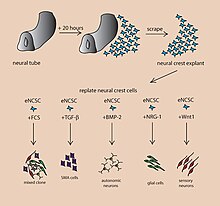
A neural, or brain organoid, describes an artificially grown, in vitro, tissue resembling parts of the human brain. Neural organoids are created by culturing pluripotent stem cells into a three-dimensional culture that can be maintained for years.[1][2] The brain is an extremely complex system of heterogeneous tissues and consists of a diverse array of neurons and glial cells. This complexity has made studying the brain and understanding how it works a difficult task in neuroscience, especially when it comes to neurodevelopmental and neurodegenerative diseases. The purpose of creating an in vitro neurological model is to study these diseases in a more defined setting. This 3D model is free of many potential in vivo limitations. The varying physiology between human and other mammalian models limits the scope of animal studies in neurological disorders. Neural organoids contain several types of nerve cells and have anatomical features that recapitulate regions of the nervous system.[3] Some neural organoids are most similar to neurons of the cortex. In some cases, the retina, spinal cord, thalamus and hippocampus.[1] Other neural organoids are unguided and contain a diversity of neural and non-neural cells. Stem cells have the potential to grow into many different types of tissues, and their fate is dependent on many factors. Below is an image showing some of the chemical factors that can lead stem cells to differentiate into various neural tissues; a more in-depth table of generating specific organoid identity has been published.[3] Similar techniques are used on stem cells used to grow cerebral organoids.[3]

- ^ a b Lancaster MA, Renner M, Martin CA, Wenzel D, Bicknell LS, Hurles ME, et al. (September 2013). "Cerebral organoids model human brain development and microcephaly". Nature. 501 (7467): 373–9. Bibcode:2013Natur.501..373L. doi:10.1038/nature12517. PMC 3817409. PMID 23995685.
- ^ Gordon A, Yoon SJ, Tran SS, Makinson CD, Park JY, Andersen J, Valencia AM, Horvath S, Xiao X, Huguenard JR, Pașca SP, Geschwind DH (March 2021). "Long-term maturation of human cortical organoids matches key early postnatal transitions". Nat Neurosci. 24 (3): 331–342. doi:10.1038/s41593-021-00802-y. PMC 8109149. PMID 33619405.
- ^ a b c Di Lullo E, Kriegstein AR (October 2017). "The use of brain organoids to investigate neural development and disease". Nature Reviews. Neuroscience. 18 (10): 573–584. doi:10.1038/nrn.2017.107. PMC 5667942. PMID 28878372.
Table 1: Protocols for brain organoid generation